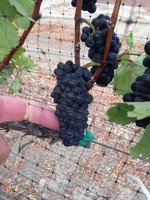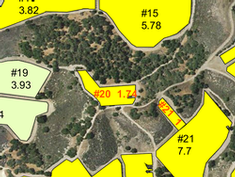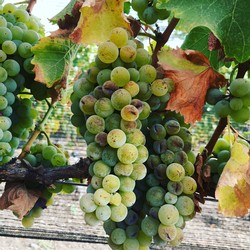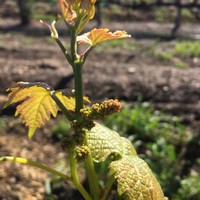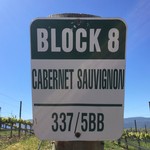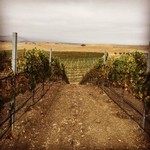
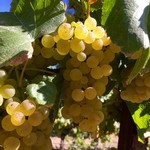 Blog
Blog
Vintage
Vintage has a profound influence on the expression of wine even making the same wine from two different years taste noticeably different. Weather plays a key role including amount of sunshine, amount and timing of rain, wind, frost, hail, etc. But insects (in particular yellow-jackets), squirrels, deer and other fauna play a huge role. These factors influence each other and weave together to influence the overall Vintage and of course the enigmatic wine's express: what the French call Terroir.
For the Seal Beach Winery portfolio I will give a quick synopsis of some recent years.
2018
What I remember the most were inconsistencies. My Sangiovese from Estelle never ripened. The Pinot Noir from the Sta. Rita Hills seemed to take a very long time to move from Veraison to ripeness (as measured by Sugar levels or BRIX) but at the end went very fast. It rained toward the end of the growing season and many picked early. The Cabernet was more normal in timing not being Harvested until mid-October. And the Grenache came off last November 1st. In Winemaking we have a saying that difficult grapes (stressed) make great wine; and, I believe this will be a very good vintage.
2017
This was the year that everything started to revert back to normal or pre-draught times. It was a very standard year with a good winter rain and a little rain in the spring. It was a cool spring with some wind. There was lots of squirrel and insect damage. The Yellow-Jackets were so bad in Tierra Alta with the Tempranillo that had trouble walking the rows for fear of being stung to death. The squirrels at Estelle would run up one side of a row and strip it of grape clusters but spare the opposite site. There berries looked beaten up and ugly that year and I remember doing a great deal of sorting to eliminate the raisons and damaged fruit. But ugly grapes make fantastic wines. My Cabernet Clone 337 on Block 8 in Estelle suffered Berry Shot (small inconsistent clusters of grapes) and we did not harvest it. Good balance with tannin, alcohol and organoleptics are characteristic of this vintage. Overall, it was a very good year for wines with excellent Reds.
2016
Wet, wet and wet was the motif for this year. The rains came back and Harold the beginning of the end of the draught (it did not official end until the rains of 2018-2019). Overall Harvest was bountiful and a little early. It was warm in the summers to very hot. Most reds were harvested in September. I believe this will be an excellent year across the board for wine.
2015
This was a crazy year. For me, the vintage most effected by the draught. SBW yields were extremely small and everything was harvested on the early timeframe. I remember the very small berries on the cluster especially with the Pinot Noir. The Chardonnay at Harvest was golden with small raison like berries. The whites and the Pinot came off early in late August. The Harrison Clarke Syrahs were very early at first week in September. Cabernet and Grenache was Mid September to beginning of October. Last off was the Cabernet Clone 101 October 8, 2015. These are very concentrated, tannic and superior wines. The reds are amazing across the board. Drink now if you must but these wines will hold up to decades of aging.
2014
Good year for yields with fruit forward and early drinking wines. I think the tannin levels were very balanced yielding Cabernet and Pinot that is very drinkable early. I taste through this year and I think these wines are delicious and a bit showy with some star potential. I do not think these are wines that I would age because they are yummy right now; but I think the reds will hold up for a decade. There was very little rain and the growing season was early with whites harvested in August, Pinot in early September and Cabernet in early October. The Tempranillo from Tierra Alta was last off on October 7th, 2014.
2013
Although there was drought the crop levels were good to larger than normal. I would sum up 2013 by saying the wines were good but not exceptional. I did not think it was a bad year but no looking at how good 2015-2018 appear to be panning out makes me downgrade the overall vintage.
I thought it would be interesting to post the notes of a prominent viticulturist in Santa Ynez. Here's a brief synopsis of some past vintages from viticulturist Jeff Newton of Coastal Vineyard Care. Jeff manages SBW vineyards: Harrison-Clarke, Happy Canyon of Santa Barbara Vineyard, McGinley Vineyard, Tommy Town, Flower & Vine (Los Alisos) and Boa Vista to name a few.
2012
The 2012 season was a long sunny year, with normal rainfall amounts during the winter months, minimal frost and mild wind during bloom-time. Warm temperatures starting in mid-July and continuing through early October helped ripen the plentiful crop load. This also made harvest for both winemakers and grape growers more intense as many varieties ripened very close together.
2011
The 2011 season was challenging for growers. The spring time began with a damaging freeze which lasted for multiple days. Later cool, windy, and rainy weather at bloom further reduce the crop. The spring and summer weather was mild, creating high mildew and botrytis pressure. The growing season included unseasonable light rain events throughout the spring, summer and fall months. With the exception of a couple of light rain events, the harvest season was warm.
2010
2010 proved to be the coolest season in memory marked by reduced vine growth, low yields and delayed ripening. Both the spring and summer were unseasonable cool with the exception of a significant heat spike in late September followed by early rains during harvest season.
2009
Drought continued for the third year in 2009 leading to both low vigor and low yields. The spring and summer were mild and cool but a late September heat spike pushed the sugars up. The harvest season was challenging due to the October rains which were followed by 90 degree weather.
2008
2008 was a tough year with less than 10 inches of rainfall and a late April freeze that contributed to low yields. Summer was mild with the exception of a late August heat spike. This heat spike lead to an early harvest which was marked by an early October freeze occurring before the completion of harvest.
2007
2007 began with below average rainfall and cold winter temperatures, which in turn lead to late budbreak. Bloom time was cool, followed by an unpredictable summer with multiple heat spikes. The weather created a long hang time and an extended harvest season.
2006
2006 was the second year in a string of wet winters. The spring bloom time period was wet and windy as well. The summer continued to be very mild creating a long growing season with a later than usual harvest.
2005
An especially wet winter created large canopies and a heavy crop load. The mild and cool spring was followed by a hot early summer and finally settled into cool late summer and fall season. This created a long maturing process for the grapes, allowing the pH and sugars to be balanced.
2004
The 2004 season began beautifully with a warm spring which was followed by a mild summer. However a significant heat wave in September accelerated ripening and lead to an early harvest. Early October rains posed a late harvest threat.
2003
Early budbreak marked the beginning of the 2003 season, followed by unseasonable spring rains during bloom which impacted fruit set. The light crop was pushed to early maturity by a significant heat spike in August.
2002
The 2002 season began with average winter rainfall and a cool early spring. The cool weather continued during bloom leading to poor fruit set. Summer and fall continued to be cool, creating a long mild growing season allowing the light crop to hang and develop slowly.
Rosé is the Passion for Summer
What is Rosé and who do we get there? Very good question which takes us down a road with many forks. Rosé can be made very sweet, semi-sweet, dry, still, sparkling, from white grapes, from grey grapes and from red grapes. They can be fresh stainless steel immediate same year release wines or aged for almost a decade in large Spanish Casks.
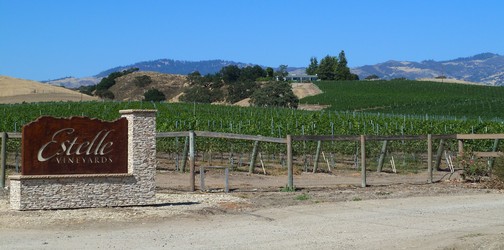
The Estelle Vineyard is in the new Los Olivos District AVA. This region is in the warmer portions of Santa Ynez Valley. The Bordeaux, Rhône and Italian varietals predominate. Grenache from Estelle is intense with a ripe Brix and acid to balance out the wines. The Rosé have a lighter pink color with notes of ripe strawberry, orange, watermelon and sometimes with a hint of allspice.
Los Alamos Vineyard
Flower & Stag Block
Fantastic Chardonnay from a Vineyard within a Vineyard
One morning I was traversing the route between breakfast at Bob's Well Bread Bakery in Los Alamos and the Winery's Crush-pad in Orcutt, when my gaze fell upon a vineyard climbing up the top of the coastal mountains. Driving down the 135 between bites of ham and cheese croissant washed down with black coffee, I pulled off the road. Where I landed was near a sign that was white with red font: Los Alamos Vineyard. 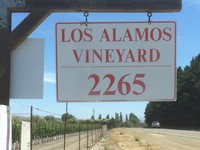 Beginning at the road side the Chardonnay was on the flat ground in a bilateral cordon trellis. Rows of vines extended completely along the flat and inclined slowly up the hillside to very near the acme. The vines wound their way up as far as I could see. This was a very large Vineyard. I was intrigued and decided to explore. It was there that I first met Tavo Acosta, the Vineyard manager. This was an extremely productive vineyard that supplied lots measured in hundreds of tons to multiple famous winery labels. I told him I was looking for something unique and small; not exactly what I was looking at on the main floor of the property. I figured I was asking for something he probably was not normally sought. And, I caught his attention. He said that his place can supply quality fruit in large amounts; and that is how it was planted.
Beginning at the road side the Chardonnay was on the flat ground in a bilateral cordon trellis. Rows of vines extended completely along the flat and inclined slowly up the hillside to very near the acme. The vines wound their way up as far as I could see. This was a very large Vineyard. I was intrigued and decided to explore. It was there that I first met Tavo Acosta, the Vineyard manager. This was an extremely productive vineyard that supplied lots measured in hundreds of tons to multiple famous winery labels. I told him I was looking for something unique and small; not exactly what I was looking at on the main floor of the property. I figured I was asking for something he probably was not normally sought. And, I caught his attention. He said that his place can supply quality fruit in large amounts; and that is how it was planted. 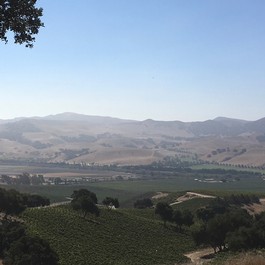 However, he knew some sweet spots that were much more with huge potential and a proven track record. Several small lots had already been developed for high end Chardonnay projects by winemakers expressing finesse and Terroir. The top, he says, check out the blocks at the very top.
However, he knew some sweet spots that were much more with huge potential and a proven track record. Several small lots had already been developed for high end Chardonnay projects by winemakers expressing finesse and Terroir. The top, he says, check out the blocks at the very top.
My first Harvest in Los Alamos was in block 18. I liked this block because it had a history of producing high-quality Chardonnay. There was right next to a very fine winemaker and chef that made Chardonnay that I appreciated. I choose a spot on a steep slope producting fantastic wine in 2015. However, in 2016 I wanted to push the envelope and see if I could find something unique. Hence, I sought something a little different.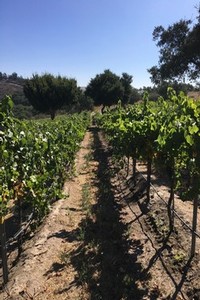
After discussing my thoughts with Tavo, he said that he thought he had something for me. It was different in the sense that it was too small to be a part of any of his other main projects. It was only 1.74 acres. It was interesting in that it was isolated: a micro-Terroir. It was Clone 4 on the Freedom Rootstock like Block 18 but the soil, topography and row direction were different. Most importantly, it was completely isolated and would be my own slice of the vineyard; my own block of Chardonnay.
Tavo drove us up to the vineyard top in his 4 x 4 as there was no way we were going to make it without it. It was a bit dicey but we finally reached the top. As we approached the Vineyard there were two things about the top: the view and an unusual tree. From where we stopped, you could look out and could see the entire valley. The 135 now looked like a little tiny stream and cars were specks. It was am amazing expanse of the entire vallley. Second, there was this tree. It sat at the entrance of the vineyard guarding this Block. Tavo said see how it looks like a stag resting on the ground with a wide base and two separate trunks in the front that extend towards the sky. I completely agreed that look like a stag. It looked like a stag guarding my little 1.74 acre curvilinear plot of fascinating Chardonnay.
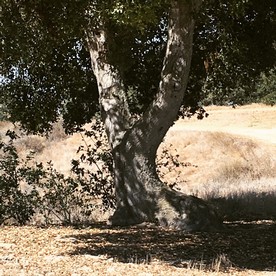
We got out of the truck he walked down the rows between the trellises. The first thing that crossed my mind is the feel of the ground. Instead of hard, solid ground my feet were sinking; it was sand. 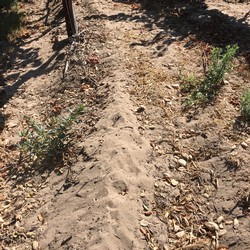 There were also several old trees randomly mixed into the vineyard. This was very interesting. The trellis was bilateral cordon with a cracked cane technique: some of the canes were directed below the canopy towards the ground. Healthy, vibrant vines with golden grapes of Chardonnay. They were beautiful. Not one bit of mildew or raisoning. I did not see any problems at all: Strong and healthy, the vine rows ran in an East West direction. They were facing the sun and there was no evidence of any sunburn. Care and time had manicured these immaculate vines. These grapes were unique. I walked around the multi-levels and felt more and more impressed. I felt connected. This is where my Chardonnay was going to grow. Then and there are I told him that this would be the land I would work. This is where I wanted to be long term. It already had a very pruned and low yield which is exactly what I wanted.
There were also several old trees randomly mixed into the vineyard. This was very interesting. The trellis was bilateral cordon with a cracked cane technique: some of the canes were directed below the canopy towards the ground. Healthy, vibrant vines with golden grapes of Chardonnay. They were beautiful. Not one bit of mildew or raisoning. I did not see any problems at all: Strong and healthy, the vine rows ran in an East West direction. They were facing the sun and there was no evidence of any sunburn. Care and time had manicured these immaculate vines. These grapes were unique. I walked around the multi-levels and felt more and more impressed. I felt connected. This is where my Chardonnay was going to grow. Then and there are I told him that this would be the land I would work. This is where I wanted to be long term. It already had a very pruned and low yield which is exactly what I wanted.

Later I was told that area before it became a vineyard was covered in rocks and dirt with nothing growing except for 1.74 acre flat where they grew a crop of flowers. It was the only use of the land in the beginning before the Vineyard was cleared and planted with grapes. This is the reason why I call this Block Flower & Stag.
The first vintage will be 2016. Stay tuned for some amazing Chardonnay.
Michael
Harvest 2016 Part One
The Weather
A polar opposite to last year, Mother Nature is cooperating in 2016. The mornings are much more usual being cool and covering most of Sta. Rita Hills in morning fog. The mid-days are mild with temperatures in the mid 70s for the most part and the late afternoons cooled by ocean breezes. There have been several peaks into the high 80s to low 90s but none of the 100 plus temperature spikes that were quite common in 2015. There is no rain in site, which should play no role whatsoever in the harvesting decisions.
The Grapes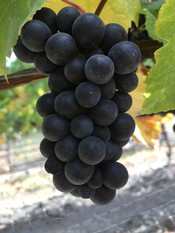
Long, mild days have produced well-balanced ripened grapes. The acidity is normally respirated or lost when the temperature get too high; this is done to help cool the grapes. But this year that has not been a problem and the acidity is well balanced with the continuous and steady increase in sugar.  Sugar is important for measuring the ripeness but also directly equates to the amount of alcohol that will be in the final wine product.
Sugar is important for measuring the ripeness but also directly equates to the amount of alcohol that will be in the final wine product.
Harvest
First to come off this year was the Pinot Grigio from Runway Vineyard on August 1st. This is always earliest as it is in the Santa Maria AVA (American Viticultural Area) and tends to ripen early. Next we took Pinot Noir from the roadside portion of Rio Vista Vineyard in the Sta. Rita Hills. Acidity was the name of the game for this harvest as these Pinot Noir Clone 667 grapes are destined to become the 2016 Rosé of Pinot. The focus of this wine is minerality, floral notes and light red fruit qualities to provide balance to food and a fine tasting Rosé.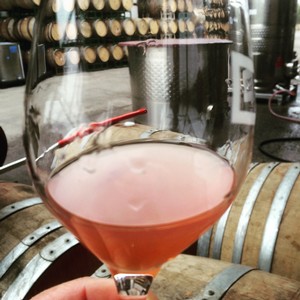
Several weeks later in mid September, the Rio Vista Vineyard from the Hillside Pinot Noir Clone 667 and the lower bluff, Clone 777 were picked to make Pinot Noir red wine. Any day now we will finish with Rio Vista by harvesting the Clone 115 that is tucked away in a small, shady little plot up the road from the main vineyard. 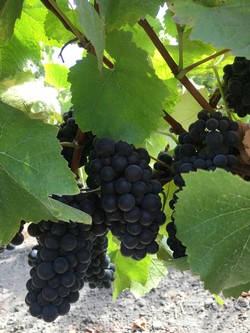 Around this time, the Rancho La Viña vineyard Pinot Noir should be nearing ripeness. This vineyard is up on a Hillside and overlooks the entire valley and Santa Rosa Road that splits the sides in half. Pinot Noir in 2016 will be very age-worthy with amazing balance, beautiful perfume noses, minerality and fruit concentration.
Around this time, the Rancho La Viña vineyard Pinot Noir should be nearing ripeness. This vineyard is up on a Hillside and overlooks the entire valley and Santa Rosa Road that splits the sides in half. Pinot Noir in 2016 will be very age-worthy with amazing balance, beautiful perfume noses, minerality and fruit concentration.
Next will be our whites: Chardonnay and Sauvignon Blanc. The Chardonnay is in Los Alamos Vineyard in Block 20 or Flower & Stag Block. It is in a 1.74 acre separated parcel that is isolated from the rest of the large vineyard. It has its own microclimate and sandy soil; stay tuned for a complete and detailed write up of this vineyard. Many fantastic and famous Chardonnays come from this site. The Sauvignon Blanc is back by popular demand. Many club members have been asking me to make Sauvignon Blanc again but it took me awhile to finally find a vineyard I liked: Two Wolves. This is abutting the Happy Canyon AVA and is the hottest of the microclimates for our wines. Sloping, steep hillside Clone 1 Sauvignon Blanc is just beautiful here and I cannot wait to make wine from this site. Look for Chardonnays with apple and pear flavors aged in oak for creaminess. The Sauvignon Blancs will be lean, with tons of minerality dominated by lots of passion fruit and guava.
After the whites are done will come Harrison-Clarke Vineyard. The upper bluff, soil-starved, stress Estrella Clone Syrah and the flat. lower expanse Alban Clone Syrah will be harvested. Both of these appear to have the perfect balance of acidity, sugar and flavor. It should be an amazing year for these Rhône varietals. I am expected intense blackberry, pepper and cola.
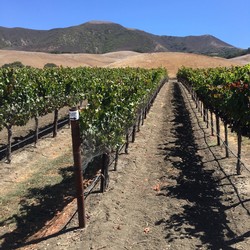 As the season progresses we will Harvest: Cabernet, Malbec and Merlot from Happy Canyon Vineyard, McGinley Vineyard and Tommy Town Vineyard all from the Happy Canyon of Santa Barbara AVA. At about the same time the Cabernet and Merlot from Estelle Vineyard should be ready which is located in the newest AVA: Los Olivos District. Late to the party will be the Cabernet Franc (Sanger Vineyard), Petite Sirah (Sanger Vineyard), Sangiovese (Estelle Vineyard) and Tempranillo (Tierra Alta Vineyard). To finish the season will be the Petit Verdot (McGinley Vineyard) and the grand finale the Grenache from Flower & Vine Vineyard (aka Alisos Vineyard).
As the season progresses we will Harvest: Cabernet, Malbec and Merlot from Happy Canyon Vineyard, McGinley Vineyard and Tommy Town Vineyard all from the Happy Canyon of Santa Barbara AVA. At about the same time the Cabernet and Merlot from Estelle Vineyard should be ready which is located in the newest AVA: Los Olivos District. Late to the party will be the Cabernet Franc (Sanger Vineyard), Petite Sirah (Sanger Vineyard), Sangiovese (Estelle Vineyard) and Tempranillo (Tierra Alta Vineyard). To finish the season will be the Petit Verdot (McGinley Vineyard) and the grand finale the Grenache from Flower & Vine Vineyard (aka Alisos Vineyard).
I will be updating more on the Harvest as it progresses.
Cheers!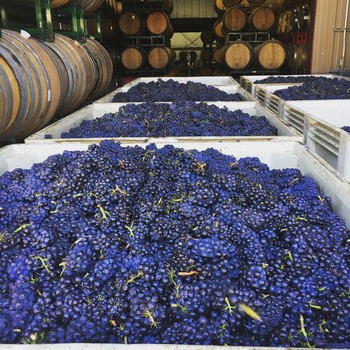
Michael
Estelle Vineyard

Facts
Appellation: Los Olivos District
Location: Estelle is the most Northeast of the vineyards that make up the Los Olivos District. It sits in its own corner abutting the Happy Canyon AVA.
Grape Varieties: Albariño, Barbera, Cabernet Sauvignon, Grenache, Grenache Blanc, Grenache Noir, Loureiro, Merlot, Mouvedre, Nebbiolo, Sangiovese, Syrah, Tempranillo, Verdehlo and Viognier.
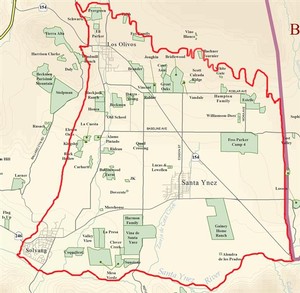
Soil: Well-drained, fine, sandy loam with a clay subsoil. Fairly broad alluvial bench underlain by terrace deposits of Orcutt sand.
Climate: Mediterranean with cool wet winters and warm dry summers. The juxtaposition to the Pacific Ocean provides cooling coastal winds and morning fog. Los Olivos is warmer than its neighbor Ballard Canyon but more temperate that its eastern Happy Canyon.
Topography: The front vineyard is relatively flat with a south-facing alluvial plain. The back (Block 8&9) has a moderately sloping terrain.
Enology
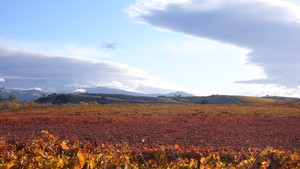
Seal Beach Winery has been working with Estelle Vineyard since 2009. The first vintage was a blend of several Blocks. Presently we are working with Cabernet Sauvignon in Blocks 8 (Clone 337), Block13 (Clone 341), Block 14 (Clone 101) and Block 16 (Clone 338).
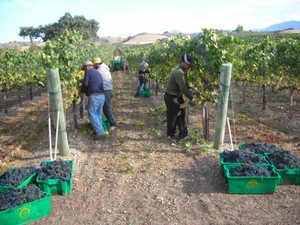
In 2016, we added Merlot Clone 181 in Block 12 and Sangiovese Clone 3 in Block 2A.
The vineyard is meticulously cared for by John and Ivan Belfy. John planted Estelle and many of the vineyards within the Santa Ynez Valley. The perfect marrying of Scion Clone, Rootstock Clone (second number after the dash—110R), soil and climate is an art form that is mystifyingly difficult and defined by an infinite number of variables. The vineyards are immaculately farmed with old school trellising and overcrops but app loaded continuous satellite monitoring. At harvest, the grapes are always beautiful and hardly require any sorting whatsoever.
It is viticulture as described above that makes the winemaking so easy. Just don’t screw it up! Is the definition of Estelle Cabernet. Crush and De-stem, into the fermenters, inoculate, press and age in barrels. It is that simple.
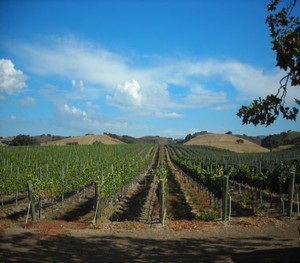
Merlot is blended into the Cabernet Clone Cuvee that we make. It is planned to have its own varietal bottling as well. The Sangiovese has been offered as a Growler wine but in the future we will be bottling this wine.
The overall intensity, varietal expression and vinified complexity set the character of Estelle Wines. Having a leaner fruit style than neighboring Happy Canyon but an uniform soil type allows great balance and long term aging.
Future
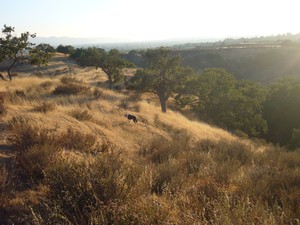
SBW has long term contracts with Estelle Vineyard and a commitment to the Cabernet Project. Estelle has been with us from the beginning and will be there as we evolve into future. Expect many new blends for the Growlers and Bottled Varietals with Estelle Grapes defining the high quality that we strive to achieve in every Vintage.
Wines
2014 Cabernet Sauvignon Clone 337
2014 Cabernet Sauvignon Clone 101 To Be Released
2015 Sangiovese (Growler) To Be Released
2015 Grenache (Growler) To Be Released
SB Winery Newsletter Volume 1
From Grapes to Glass, providing insight into enology, viticulture & taste that is Your Winery.
The Season
The flowers have set and budbreak is upon us. We now have a little tiny grapes making up little clusters. 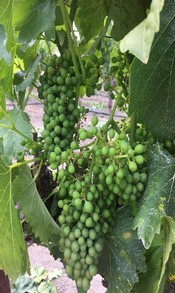 These green clusters will continue to grow, accumulate sugar and respire acid until Veraison; when they change color to white or Red. This is usually in mid-July.
These green clusters will continue to grow, accumulate sugar and respire acid until Veraison; when they change color to white or Red. This is usually in mid-July.
Santa Ynez AVA
The 2015 vintage was most representative of the California drought. The vines were stressed from a very early time period. The lack of water starved the vines and reduced yield. To compound this problem, an early Spring wind blew at the time of flowering. 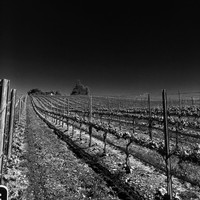 Flowers are very delicate and wind can blow the flowers off the vine. The flowers after pollination are what produces grape clusters. So this wind essentially thinned or reduce the clusters, which meant less grapes per vine. This reduced the overall yield.
Flowers are very delicate and wind can blow the flowers off the vine. The flowers after pollination are what produces grape clusters. So this wind essentially thinned or reduce the clusters, which meant less grapes per vine. This reduced the overall yield.
In this Terroir, the stressed vines tend to produce small berries, less grapes per cluster and less clusters per vine.
On the bright side, this has produced fantastic wine. Dark, rich and concentrated Pinot Noir and Cabernet highlight an excellent vintage. Into 2015, we also added Petite Verdot, Merlot and we are doing our second year of Tempranillo. The Syrah on the hilltop Vineyard of Harrison-Clarke again produced amazingly rich wines with layers of depth.
New Wines and Bottling Update
Our newest addition to the Seal Beach Winery portfolio is the Natalie Grace 2012 Grenache from Alisos Vineyard. 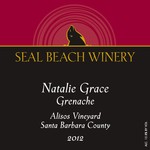 We have been working in this Vineyard since 2008. Later this year we will release the 2012 Syrah from Alisos Vineyard. We also have a new Viognier from Brickbarn vineyard in Santa Ynez Valley AVA. In August we will be bottling 2015 Chardonnay and the 2014 Cabernet Sauvignon Clone 337 Estelle Vineyard Los Olivos District AVA. On June 4th, we had our first Winemaker's Dinner at Delius Restaurant in Long Beach. Everyone had a great time with wonderful Wine and Food pairings. That was the night we first offered our latest Futures purchase.
We have been working in this Vineyard since 2008. Later this year we will release the 2012 Syrah from Alisos Vineyard. We also have a new Viognier from Brickbarn vineyard in Santa Ynez Valley AVA. In August we will be bottling 2015 Chardonnay and the 2014 Cabernet Sauvignon Clone 337 Estelle Vineyard Los Olivos District AVA. On June 4th, we had our first Winemaker's Dinner at Delius Restaurant in Long Beach. Everyone had a great time with wonderful Wine and Food pairings. That was the night we first offered our latest Futures purchase.
Now for a limited time, the 2014 Cabernet Clone 337 Estelle Vineyard Los Olivos District AVA is for sale in barrel. Each case of 12 bottles is offered for $300, well below the retail price of $480 and the Wine Club discounted price of $324. But this deal will be done when the wine is moved from barrel to bottle in August 2016; so if you are interested act now.
Much variety will be found in our Reds from 2014: Cabernet, Pinot Noir, Tempranillo, Zinfandel and Syrah. Look for these wines to release throughout 2017.
Wine Growlers
As Summer nears, we are about to have our thousandth fill for each of the 1.0L & 1.9L growlers. This is an extremely popular program and if you are a Wine Club member and not yet a Growler member I encourage you to look into this further. We just added a 1.5 L disposable growler this year. 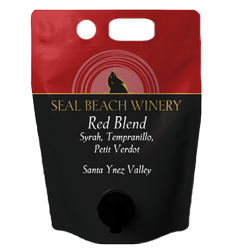 It has a very low environmental profile made from recycled materials and completely is recyclable itself. It has an airtight spout dispensing system, that will keep your wine fresh as long as you drink it. Look forward to many new growler additions in the second half of 2015: Sangiovese, Cabernet Franc, Petite Syrah, Rosé of Grenache, Barbera, a Rhône blend of Grenache & Syrah, and many others. My plan is to have six different growler wines to choose from at all times.
It has a very low environmental profile made from recycled materials and completely is recyclable itself. It has an airtight spout dispensing system, that will keep your wine fresh as long as you drink it. Look forward to many new growler additions in the second half of 2015: Sangiovese, Cabernet Franc, Petite Syrah, Rosé of Grenache, Barbera, a Rhône blend of Grenache & Syrah, and many others. My plan is to have six different growler wines to choose from at all times.
New changes?
Seal Beach Winery🍷 has recently redone their entire Internet site. Our website is now mobile enabled and we have links to all of our social platforms. This ease-of-use and modern update makes the website beautiful and very functional. In addition, we have a new point-of-sale software that will help serve you better with direct table-side service.
Hope to see you soon,
Cheers!
Michael

